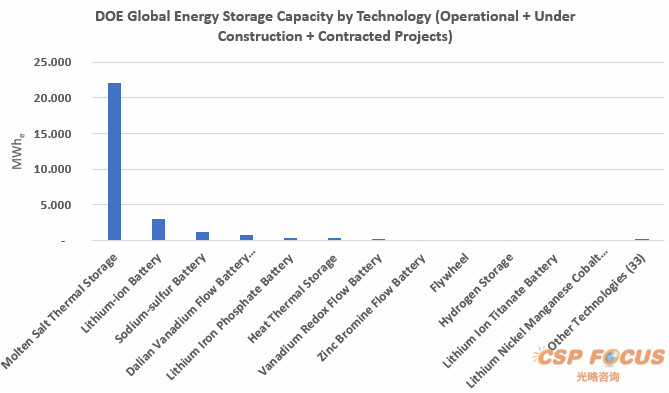Home > Market > Other Regions > Here
Concentrated Solar Power, renewable and storage, by Luis Crespo (Protermosolar)
2019.09.17 From: HELIOSCSP
Who has said that renewables will always need the support of fossil or nuclear technologies to provide the supply?
It
is true that the cheapest and most widespread technologies in Spain,
such as wind energy and photovoltaic, do not have storage in centralized
facilities (wind farms and photovoltaic plants) and that add some hour
of storage in batteries would significantly increase the cost of their
generation and would cease to be competitive.
The current
regulation of the markets and, basically, also the consumers, look for
the cost of the supply at any time of the day in the smaller possible.
If, in addition, the planners are serious about moving decisively
towards the discharge of the electricity sector, the clear objective in
this process of energy transition will be to find, at every hour of the
day, the renewable technology offered by its generation at the lowest
price.

With the foreseeable and desirable deployment of new wind power installations and, to a greater extent, photovoltaic, a significant decrease in fossil support will be achieved at all times in the various facilities that are in operation, by having solar and wind energy resources necessary. The resulting wind power production, on average, relatively balanced during the day and night throughout the country and can increase its installed power until business plans touch their threshold of profitability, due to spills and price deflation produced in the market in windy periods. Photovoltaic installations, meanwhile, have their production limited to the central hours of the day, from two or three hours after sunrise to an equivalent period before sunset. That is, the remaining fleet of power plants in the country that must be prepared every day at dusk to respond to the loss of all installed photovoltaic power.
The
issues that should be beginning to be questioned in the planning of the
controlled electricity sector: Could the rest of the renewable ones
respond to this problem when the installed photovoltaic power approaches
20 GW? Will it be necessary to install the very expensive battery
systems, which with an equivalent capacity, have been charged by another
set of photovoltaic installations of similar power dedicated during the
day to that end? However, it seems that the position that creates less
discomfort is to continue maintaining the nuclear park and fossil power
plants to have guaranteed support, although it is a cost to continue
generating more radioactive waste and CO2 emissions.
Fortunately,
we have renewable resources in Spain both on a daily basis – unstable
or sunny days – and in the different seasons of the year, in the wind,
water and sun they are quite complementary. In addition, we have the
little explored potential of proactive demand management, as well as the
interconnections with neighboring countries, Portugal, France and
Morocco, our capacities are growing in the coming years. Therefore,
rapid growth of wind energy and solar technologies (photovoltaic + solar
thermal), taking into account their natural complementarity and
flexibility that can help demand management (interruptibility and
adaptation of consumption curves) together with reinforced
interconnections with our neighboring countries could make us move
towards an electricity generation with very limited limitations.
But,
in addition to all this we have three technologies with a relevant
installed capacity or future potential, which, with a management
oriented to the benefit of the system and without reducing reasonable
rates of return, would greatly avoid fossil support in the future. These
technologies are great hydraulics (including pumping), biomass and
solar thermal.
Hydraulics and biomass have the previously stored
resource and, to a large extent, their operation could be managed in the
future in a way that complements wind turbines and solar power
productions in order to avoid maximum generation with emissions from
coal plants or gas. For example, new biomass plants that went to an
auction can be remunerated under the “take or pay” formula for a high
number of annual hours of operation, and their production can be
arranged mostly for those periods in which they escape wind resources
and solar.
But, in addition to this natural complementarity and
flexibility in the operation of biomass and hydroelectric power plants,
fortunately we have in our country another technology, concentrating
solar thermal, which uses the abundant solar resource and has thermal
storage as an essential element in all new facilities. The park
installed since 2007 has been demonstrating its great reliability of
operation without symptoms of degradation and, in addition, Spain is the
world leader in this technology.
Thanks to thermal storage,
photovoltaic production could be complemented on sunny days after sunset
and throughout the night, since there is no significant loss of
performance between operating when the sun shines or storing all the
energy to dispatch it from sunset. In this way, the need to have a large
fleet of combined cycles to respond to the fall of photovoltaic
production every afternoon in addition to avoiding the need for fossil
backup throughout the night and at costs that are already close to those
of the combined cycles and that, with total security, will be more
competitive than these sooner rather than later, before 2030, since the
costs of the solar thermal will continue to be reduced while those of
the combined cycles, due to the evolution of the cost of gas and
emissions, will only grow in the coming years.
On the other hand,
the thermal storage of concentrated solar power plants can be used as a
strategic reserve during most of the year since its maximum volume is
only necessary for daily operation during the summer months. Thus, the
solar thermal power plants could offer absolute availability of all the
new installed power, during the winter, spring and autumn, regardless of
whether the day (or the previous days) had been sunny. This
availability could be offered for a certain period (eg between 3 and 6
hours) which would flatten the relative maximums of the pool price for a
good number of days per year and allow the system operator to always
have the solar thermal power plants for the moments of maximum annual
demand, regardless of whether that particular day or the previous ones
had been sunny or not.
Given the eventual scenario that the
discharges from wind farms or photovoltaic plants were significant,
solar thermal power plants could install electric heaters to thermally
store these discharges with investment costs 50 times lower than those
that would have large battery storage systems or pumping stations.
The
energy transition in the electricity sector, to reach renewable
production quotas greater than 85%, is absolutely possible thanks not
only to the large estimated wind turbines and photovoltaic productions,
together with the invaluable and continued contribution of hydroelectric
power plants and a certain increase in biomass, but, above all, the
role that solar thermal power plants, with their powerful and flexible
thermal storage system, will play in the future. All of this, together
with the proactive management of demand, may reduce fossil power plant
support to its minimum expression.
Luis Crespo is president of Protermosolar.
Upcoming CSP events:
3rd CSP Focus Innovation 2019(Oct.24-25, Beijing China)
10th CSP Focus China 2020 (March, Beijing China)
More CSP news and reports please visit www.cspfocus.cn
or CSP Focus social media on LinkedIn, Twitter, Facebook.
More from CSP Focus
NextConcrete base of CSP tower for 4th phase of Mohammed bin Rashid Al Maktoum Solar Park now complete
Construction progress on MBR Solar Park – Phase 4's 260m solar tower
Designing Solar Furnaces to Make Biochars without Air Pollution
California Looks for Long-Duration Renewable Energy Storage Contracts for 2026
Ivanpah Concentrated Solar Power tower plant now on pace to meet goal
Vast plans $600m “baseload” concentrated solar power plant for Mt Isa
Make Carnot Batteries with Molten Salt Thermal Energy Storage in ex-Coal Plants
NREL scientists advance solar thermo-chemical hydrogen (STCH) production
Leave your thoughts here
Reports(Member Only)
See more+-
CSP Focus Membership Proposals
We are now proposing CSP Focus Membership, hoping to better serve our members to keep pace with the latest updates of ongoing CSP projects worldwide, and to establish and maintain business relations with major shareholders of the projects. CSP Focus offers to Membership exclusive access to:1. Daily/Weekly update and analysis on CSP policies, projects, technologies, market trend and corporate relea
-
The Latest CSP Focus Monthly Update
Join CSP Focus Membership to Get the Latest CSP Focus Monthly Update December Edition.
-
CSP Project Monthly Update 2022 December Edition
CSP Focus is presenting CSP Project (China) Update 2022 December Edition.Detail report is available for CSP Focus Membership.
-
Presentations-CSP Focus China 2021
The Report is for CSP Focus Members only.
Upcoming Events
See more+-
12th CSP Focus China 2022
2022.04.21-22 Beijing
-
11th CSP Focus China 2021
2021.10.28-29 Beijing
-
10th CSP Focus China 2020
2020.10.22-23 Beijing, China
Project Updates
See more+-
Lanzhou Dacheng Dunhuang CSP Project
Asia Pacific-China,Operational,Parabolic Trough
-
Luneng Haixi 50MW Molten Salt Tower CSP Project
Asia Pacific-China,Operational,Power Tower
-
Dubai 950MW NOOR Energy 1 CSP+PV Project
MENA-UAE,Under construction,Power Tower
-
Power China Gonghe 50MW Molten Salt Tower CSP Project
Asia Pacific-China,Operational,Power Tower






